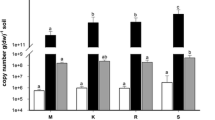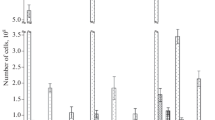Abstract
Microbial communities in subsurface soil are specialized for their environment, which is distinct from that of the surface communities. However, little is known about the microbial communities (bacteria and fungi) that exist in the deeper soil horizons. Vertical changes in microbial alpha-diversity (Chao1 and Shannon indices) and community composition were investigated at four soil depths (0–10, 10–20, 20–40, and 40–60 cm) in a natural secondary forest of Betula albosinensis by high-throughput sequencing of the 16S and internal transcribed spacer rDNA regions. The numbers of operational taxonomic units (OTUs), and the Chao1 and Shannon indices decreased in the deeper soil layers. Each soil layer contained both mutual and specific OTUs. In the 40–60 cm soil layer, 175 and 235 specific bacterial and fungal OTUs were identified, respectively. Acidobacteria was the most dominant bacterial group in all four soil layers, but reached its maximum at 40–60 cm (62.88%). In particular, the 40–60 cm soil layer typically showed the highest abundance of the fungal genus Inocybe (47.46%). The Chao1 and Shannon indices were significantly correlated with the soil organic carbon content. Redundancy analysis indicated that the bacterial communities were closely correlated with soil organic carbon content (P = 0.001). Collectively, these results indicate that soil nutrients alter the microbial diversity and relative abundance and affect the microbial composition.
Similar content being viewed by others
References
Bååth, E. and Söderström, B. 2011. Degradation of macromolecules by microfungi isolated from different podzolic soil horizons. Can. J. Bot. 58, 422–425.
Baldrian, P., Kolarík, M., Stursová, M., Kopecký, J., Valášková, V., Vetrovský, T., Zifcáková, L., Snajdr, J., Rídl, J., Vlcek, C., et al. 2012. Active and total microbial communities in forest soil are largely different and highly stratified during decomposition. ISME J. 6, 248–258.
Blume, E., Bischoff, M., Reichert, J.M., Moorman, T., Konopka, A., and Turco, R.F. 2002. Surface and subsurface microbial biomass, community structure and metabolic activity as a function of soil depth and season. Appl. Soil Ecol. 20, 171–181.
Boer, W.D., Folman, L.B., Summerbell, R.C., and Boddy, L. 2005. Living in a fungal world: impact of fungi on soil bacterial niche development. FEMS Microbiol. Rev. 29, 795–811.
Bremner, J.M. 1996. Nitrogen-Total. In Sparks, D.L., Page, A.L., Helmke, P.A., Loeppert, R.H., Soltanpour, P.N., Tabatabai, M.A., Johnston, C.T., and Sumner, M.E. (eds.) Methods of Soil Analysis, pp. 1085–1121. Part 3-Chemical Methods, Soil Science Society of America Inc., Madison, USA.
Buée, M., Reich, M., Murat, C., Morin, E., Nilsson, R.H., Uroz, S., and Martin, F. 2009. 454 Pyrosequencing analyses of forest soils reveal an unexpectedly high fungal diversity. New Phytol. 184, 449–456.
Cheng, F., Wei, X., Hou, L., Shang, Z., Peng, X., Zhao, P., Fei, Z., and Zhang, S. 2015. Soil fungal communities of montane natural secondary forest types in China. J. Microbiol. 53, 379–389.
Clemmensen, K.E., Bahr, A., Ovaskainen, O., Dahlberg, A., Ekblad, A., Wallander, H., Stenlid, J., Finlay, R.D., Wardle, D.A., and Lindahl, B.D. 2013. Roots and associated fungi drive long-term carbon sequestration in boreal forest. Science 339, 1615–1618.
Costello, E.K. and Schmidt, S.K. 2006. Microbial diversity in alpine tundra wet meadow soil: novel chloroflexi from a cold, watersaturated environment. Appl. Environ. Microbiol. 8, 1471–1486.
Ding, X., Wu, C., Huang, J., and Zhou, R. 2015. Interphase microbial community characteristics in the fermentation cellar of chinese Luzhou-flavor liquor determined by PLFA and DGGE profiles. Food Res. Int. 72, 16–24.
Dion, P. 2008. Extreme views on prokaryote evolution, pp. 45–70. In Dion, P. and Nautiyal, C.S. (eds.), Microbiology of extreme soils, Springer, Berlin Heidelberg, Germany.
Edgar, R.C. 2010. Search and clustering orders of magnitude faster than BLAST. Bioinformatics 26, 2460–2461.
Edgar, R.C. 2013. UPARSE: highly accurate OTU sequences from microbial amplicon reads. Nat. Methods 10, 996–998.
Edwards, I.P. and Zak, D.R. 2010. Phylogenetic similarity and structure of Agaricomycotina communities across a forested landscape. Mol. Ecol. 19, 1469–1482.
Eilers, K.G., Debenport, S., Anderson, S., and Fierer, N. 2012. Digging deeper to find unique microbial communities: the strong effect of depth on the structure of bacterial and archaeal communities in soil. Soil Biol. Biochem. 50, 58–65.
Fazi, S., Amalfitano, S., Pernthaler, J., and Puddu, A. 2005. Bacterial communities associated with benthic organic matter in headwater stream microhabitats. Environ. Microbiol. 7, 1633–1640.
Fierer, N., Bradford, M.A., and Jackson, R.B. 2008. Toward an ecological classification of soil bacteria. Ecology 88, 1354–1364.
Fogel, R. and Hunt, G. 1979. Fungal and arboreal biomass in a western oregon douglas-fir ecosystem: distribution patterns and turnover. Can. J. Forest. Res. 9, 245–256.
Fritze, H., Pietikäinen, J., and Pennanen, T. 2000. Distribution of microbial biomass and phospholipid fatty acids in podzol profiles under coniferous forest. Eur. J. Soil Sci. 51, 565–573.
Geng, R., Geng, Z., Huang, J., He, W., Hou, L., She, D., Zhao, J., and Shang, J. 2015. Diversity of ectomycorrhizal fungi associated with picea asperata in xin jiashan forest of qinling mountains. Wei Sheng Wu Xue Bao [Article in Chinese] 55, 905–915.
Gross, K.L., Pregitzer, K.S., and Burton, A.J. 1995. Spatial variation in nitrogen availability in three successional plant communities. J. Ecol. 83, 357–367.
Hakulinen, R., Kähkö nen, M.A., and Salkinoja-Salonen, M. 2005. Vertical distribution of sediment enzyme activities involved in the cycling of carbon, nitrogen, phosphorus and sulphur in three boreal rural lakes. Water Res. 39, 2319–2326.
Högberg, M.N., Briones, M.J., Keel, S.G., Metcalfe, D.B., Campbell, C., Midwood, A.J., Thornton, B., Hurry, V., Linder, S., Näsholm, T., et al. 2008. Quantification of effects of season and nitrogen supply on tree below-ground carbon transfer to ectomycorrhizal fungi and other soil organisms in a boreal pine forest. New Phytol. 187, 485–493.
Jones, R.T., Robeson, M.S., Lauber, C.L., Hamady, M., Knight, R., and Fierer, N. 2009. A comprehensive survey of soil acidobacterial diversity using pyrosequencing and clone library analyses. ISME J. 3, 442–453.
Joshi, G. and Negi, G.C.S. 2015. Physico-chemical properties along soil profiles of two dominant forest types in Western Himalaya. Curr. Sci. India 109, 798–803.
Kasel, S., Bennett, L.T., and Tibbits, J. 2008. Land use influences soil fungal community composition across central Victoria, southeastern Australia. Soil Biol. Biochem. 40, 1724–1732.
Langenheder, S. and Székely, A.J. 2011. Species sorting and neutral processes are both important during the initial assembly of bacterial communities. ISME J. 5, 1086–1094.
Lauber, C.L., Hamady, M., Knight, R., and Fierer, N. 2009. Pyrosequencing-based assessment of soil pH as a predictor of soil bacterial community structure at the continental scale. Appl. Environ. Microbiol. 75, 5111–5120.
Lauber, C.L., Strickland, M.S., Bradford, M.A., and Fierer, N. 2008. The influence of soil properties on the structure of bacterial and fungal communities across land-use types. Soil Biol. Biochem. 40, 2407–2415.
Li, H., Ye, D., Wang, X., Settles, M.L., Wang, J., and Hao, Z. 2014. Soil bacterial communities of different natural forest types in Northeast China. Plant Soil 383, 203–216.
Lindahl, B.D., Ihrmark, K., Boberg, J., Trumbore, S.E., Högberg, P., Stenlid, J., and Finlay, R.D. 2007. Spatial separation of litter decomposition and mycorrhizal nitrogen uptake in a boreal forest. New Phytol. 173, 611–620.
López-Mondéjar, R., Voríšková, J., Vetrovský, T., and Baldrian, P. 2015. The bacterial community inhabiting temperate deciduous forests is vertically stratified and undergoes seasonal dynamics. Soil Biol. Biochem. 87, 43–50.
Maidak, B.L., Olsen, G.J., Larsen, N., Overbeek, R., McCaughey, M.J., and Woese, C.R. 1997. The RDP (ribosomal database project). Nucleic Acids Res. 25, 109–110.
McCaig, A.E., Glover, L.A., and Prosser, J.I. 1999. Molecular analysis of bacterial community structure and diversity in unimproved and improved upland grass pastures. Appl. Environ. Microbiol. 65, 1721–1730.
O’Brien, H.E., Parrent, J.L., Jackson, J.A., Moncalvo, J.M., and Vilgalys, R. 2005. Fungal community analysis by large-scale sequencing of environmental samples. Appl. Environ. Microbiol. 71, 5544–5550.
Osborn, A.M., Moore, E.R.B., and Timmis, K.N. 2000. An evaluation of terminal-restriction fragment length polymorphism (T-RFLP) analysis for the study of microbial community structure and dynamics. Environ. Microbiol. 2, 39–50.
Peralta, R.M., Ahn, C., and Gillevet, P.M. 2013. Characterization of soil bacterial community structure and physicochemical properties in created and natural wetlands. Sci. Total Environ. 443, 725–732.
Robertson, G.P., Hutson, M.A., Evans, F.C., and Tiedje, J.M. 1988. Spatial variability in a successional plant community: patterns of nitrogen availability. Ecology 69, 1517–1524.
Roesch, L.F., Fulthorpe, R.R., Riva, A., Casella, G., Hadwin, A.K., Kent, A.D., Daroub, S.H., Camargo, F.A., Farmerie, W.G., and Triplett, E.W. 2007. Pyrosequencing enumerates and contrasts soil microbial diversity. ISME J. 1, 283–290.
Rousk, J., Bååth, E., Brookes, P.C., Lauber, C.L., Lozupone, C., Caporaso, J.G., Knight, R., and Fierer, N. 2010. Soil bacterial and fungal communities across a pH gradient in an arable soil. ISME J. 4, 1340–1351.
Schadt, C.W., Martin, A.P., Lipson, D.A., and Schmidt, S.K. 2003. Seasonal dynamics of previously unknown fungal lineages in tundra soils. Science 301, 1359–1361.
Senga, Y., Hiroki, M., Nakamura, Y., Watarai, Y., Watanabe, Y., and Nohara, S. 2011. Vertical profiles of DIN, DOC, and microbial activities in the wetland soil of Kushiro Mire, northeastern Japan. Limnology 12, 17–23.
Smith, S.E., Smith, F.A., and Jakobsen, I. 2003. Mycorrhizal fungi can dominate phosphate supply to plants irrespective of growth responses. Plant Physiol. 133, 16–20.
Šnajdr, J., Cajthaml, T., Valášková, V., Merhautová, V., Petránková, M., Spetz, P., Leppänen, K., and Baldrian, P. 2011. Transformation of Quercus petraea, litter: successive changes in litter chemistry are reflected in differential enzyme activity and changes in the microbial community composition. FEMS Microbiol. Ecol. 75, 291–303.
Šnajdr, J., Valášková, V., Merhautová, V., Herinková, J., Cajthaml, T., and Baldrian, P. 2008. Spatial variability of enzyme activities and microbial biomass in the upper layers of Quercus petraea, forest soil. Soil Biol. Biochem. 40, 2068–2075.
Stribley, D.P., Tinker, P.B., and Rayner, J.H. 1980. Relation of internal phosphorus concentration and plant weight in plants infected by vesicular-arbuscular mycorrhizas. New Phytol. 86, 261–266.
Štursová, M., Žifcáková, L., Leigh, M.B., Burgess, R., and Baldrian, P. 2012. Cellulose utilization in forest litter and soil: identification of bacterial and fungal decomposers. FEMS Microbiol. Ecol. 80, 735–746.
Thomas, G.W. 1996. Soil pH and soil acidity, pp. 475–490. In Sparks, D.L., Page, A.L., Helmke, P.A., Loeppert, R.H., Soltanpour, P.N., Tabatabai, M.A., Johnston, C.T., and Sumner, M.E. (eds.), Methods of Soil Analysis. Part 3. Soil Science Society of America. Sparks D, USA.
Tiquia, S.M., Lloyd, J., Herms, D.A., Hoitink, H.A.J., and Michel, F.C.Jr. 2002. Effects of mulching and fertilization on soil nutrients, microbial activity and rhizosphere bacterial community structure determined by analysis of TRFLPs of PCR-amplified 16S rRNA genes. Appl. Soil Ecol. 21, 31–48.
VoRÍšková, J. and Baldrian, P. 2013. Fungal community on decomposing leaf litter undergoes rapid successional changes. ISME J. 7, 477–486.
Voríšková, J., Brabcová, V., Cajthaml, T., and Baldrian, P. 2014. Seasonal dynamics of fungal communities in a temperate oak forest soil. New Phytol. 201, 269–278.
Xu, Z.Y., Tang, M., Chen, H., Ban, Y.H., and Zhang, H.H. 2012. Microbial community structure in the rhizosphere of Sophora viciifolia grown at a lead and zinc mine of northwest China. Sci. Total Environ. 435–436, 453–464.
Walkley, A. 1935. An examination of methods for determining organic carbon and nitrogen in soils. (with one text-figure.). J. Agricul. Sci. 25, 598–609.
Wang, D., Geng, Z.C., She, D., He, W.X., and Hou, L. 2015. Soil organic carbon storage and vertical distribution of carbon and nitrogen under different forest types in the Qinling mountains. (in Chinese) Chinese J. Appl. Ecol. 25, 1569–1577.
Yao, X.M., Guo-Zhong, L., Yang, H., Zhao, Z.H., and Chen, R. 2007. Studies of fungal flora in forest soil of Changbai mountains. J. Fungal Res. (in Chinese) 5, 43–46.
Žifcáková, L., Vetrovský, T., Howe, A., and Baldrian, P. 2015. Microbial activity in forest soil reflects the changes in ecosystem properties between summer and winter. Environ. Microbiol. 18, 288–301.
Author information
Authors and Affiliations
Corresponding author
Additional information
Supplemental material for this article may be found at http://www.springerlink.com/content/120956.
Electronic supplementary material
Rights and permissions
About this article
Cite this article
Du, C., Geng, Z., Wang, Q. et al. Variations in bacterial and fungal communities through soil depth profiles in a Betula albosinensis forest. J Microbiol. 55, 684–693 (2017). https://doi.org/10.1007/s12275-017-6466-8
Received:
Revised:
Accepted:
Published:
Issue Date:
DOI: https://doi.org/10.1007/s12275-017-6466-8




